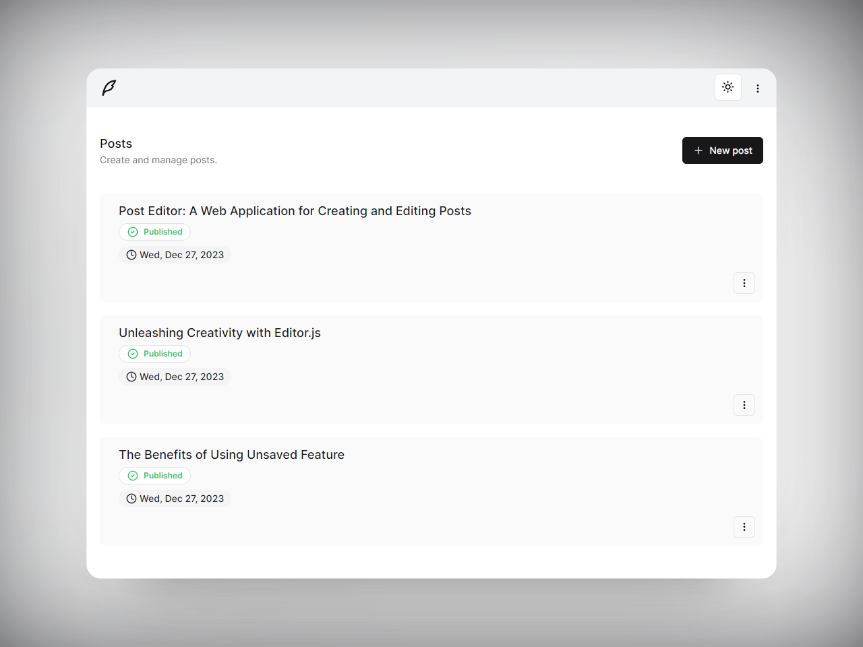
Post Editor is a web application that allows you to create and edit posts with rich text and images. You can use it to write blog posts, articles, tutorials, or any other type of content that you want to share online.
Post Editor is built with Next.js 14, Shadcn UI, Prisma, EditorJS, and a PostgreSQL database. It provides a user-friendly interface for creating, editing, and managing posts. It also integrates Cloudinary for seamless image upload, storage, and management.
Project Purpose and Goal
The purpose of the project is to provide a user-friendly web application, named "Post Editor," for creating and editing posts with rich text and images. The primary goal is to offer a versatile platform that allows users to write and manage various types of content, such as blog posts, articles, tutorials, etc., with a focus on a seamless and visually appealing experience. The application aims to streamline the post creation and editing process, enhancing user interaction through features like rich text editing and Cloudinary-powered image upload.
Web Stack and Explanation:
The web application is built using a modern and robust tech stack:
-
Next.js 14: The choice of Next.js as the framework enables server-side rendering (SSR), enhancing performance and search engine optimization (SEO).
-
Shadcn UI: The UI components from Shadcn UI are integrated to enhance the aesthetics and usability of the application, providing a visually pleasing and user-friendly interface.
-
Prisma: Used as the Object-Relational Mapping (ORM) tool, Prisma facilitates interaction with the PostgreSQL database, allowing for efficient data management and retrieval.
-
PostgreSQL: The application relies on PostgreSQL as the database for storing and retrieving post-related data.
-
EditorJS: Integrated for rich text editing, EditorJS provides a customizable and user-friendly experience for creating and editing textual content.
-
Cloudinary: The inclusion of Cloudinary facilitates seamless image upload, storage, and management within the posts, enhancing the overall multimedia capabilities of the application.
Problems and Thought Process:
The development process involves addressing several challenges and considerations:
-
Database Setup: Setting up and configuring the PostgreSQL database with appropriate credentials is a prerequisite, ensuring secure and efficient data storage.
-
Environment Configuration: Configuring the environment variables, including Cloudinary credentials, requires careful attention to enable features like image upload seamlessly.
-
Dependencies and Packages: Managing and installing dependencies using npm is a crucial step, and the inclusion of Next.js, Prisma, Shadcn UI, etc., contributes to the overall functionality and aesthetics of the application.
-
Migrations: Running database migrations using Prisma ensures that the database schema is aligned with the application's evolving requirements.
-
Cloudinary Integration: Integrating Cloudinary involves obtaining API key, API secret, and cloud name, and updating the application's environment variables (.env file) to enable image upload features.
Lessons Learned:
The development of Post Editor provides valuable lessons:
-
Tech Stack Synergy: The combination of Next.js, Shadcn UI, Prisma, and other technologies showcases the importance of choosing a well-integrated and complementary tech stack for efficient development.
-
User Experience Focus: Features like rich text editing and Cloudinary image upload emphasize the importance of prioritizing user experience, making the application more appealing and functional.
-
Environment Management: Handling environment variables and sensitive information, as demonstrated through the use of .env files, is critical for security and configuration purposes.
-
Contributions and Collaboration: The project is open to contributions, emphasizing the collaborative nature of development. Establishing contribution guidelines ensures a streamlined and organized development process.